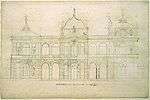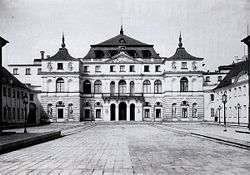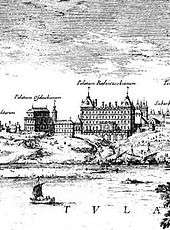Brühl Palace, Warsaw
The Brühl Palace (Polish: Pałac Brühla), formerly known as Sandomierski Palace, was a palatial residence standing at Piłsudski Square, in central Warsaw, Poland. It was one of the largest palaces and one of the finest examples of rococo architecture in pre-World War II Warsaw.
| Brühl Palace Pałac Brühla (in Polish) | |
|---|---|
Main gate and the corps de logis. | |

| |
| General information | |
| Architectural style | Baroque |
| Town or city | Warsaw |
| Country | Poland |
| Construction started | 1639 |
| Completed | 1642 |
| Demolished | 1944 |
| Client | Jerzy Ossoliński |
| Design and construction | |
| Architect | Lorenzo de Sent, rebuilt by Tylman Gamerski (late 17th century) and Johann Friedrich Knöbel, Joachim Daniel von Jauch (18th century) |
History
The palace was built between 1639–42 by Lorenzo de Sent for Crown Grand Chancellor Jerzy Ossoliński in Mannerist style. It was built on the plan of an elongated rectangle with two hexagonal towers at garden side of the building.[1] The palace was adorned with sculptures - an allegory of Poland above the main portal, four figures of kings of Poland in the niches and a statue of Minerva crowning the roof. A possible inspiration for the palace's upper pavilion and its characteristic roof was Bonifaz Wohlmut's reconstruction of Belvedere in Prague, 1557–1563.
After the Chancellor's death the property was inherited by his daughter Helena Tekla Ossolińska, wife of Aleksander Michał Lubomirski, Starost of Sandomierz (from whom it takes its name). Later, between 1681–96, it was rebuilt and remodeled by Tylman Gamerski and Giovanni Bellotti for Prince Józef Karol Lubomirski - Aleksander Michał's son.
In 1750, Heinrich von Brühl bought the palace as a residence. Between 1754–59 it was rebuilt according to designs by Johann Friedrich Knöbel and Joachim Daniel von Jauch.[1] The palace was enhanced and covered with a mansard roof. Two outbuildings were added to the palace complex surrounding a triangular courtyard that sometimes served as a parade ground. From that time the palace was known as the Brühl Palace.
On 27 May 1787, the Palace played a key role in a plot by Russian ambassador to Poland, Otto Magnus von Stackelberg. He derailed yet another Polish policy which seemed threatening to Russia. With few major wars in the past decades, the economy of the Commonwealth was improving, and its budget had a notable surplus. Many voices said that the money should be spent on increasing the size, and providing new equipment for, the Polish army. However, as a large Polish army could be a threat to the Russian garrisons controlling Poland, von Stackelberg ordered his proxies in the Permanent Council to spend the money on a different goal: for the huge sum of 1 million zloty's (representing most of the surplus), the Council bought the Brühl Palace - and promptly donated it to 'Poland's ally', Russia, to serve as Russia's new embassy.


At the end of the eighteenth century, Dominik Merlini gave the interior a neoclassical look.[1]
During 1932–37, the palace was adapted for use as the Ministry for Foreign Affairs of the new Polish Republic. The architect this time was Bohdan Pniewski, who added a new modern building and modernized the interiors of all the buildings in the palace complex.[1]
It was deliberately and completely destroyed by the Germans on December 18, 1944 (during World War II, shortly after the Warsaw Uprising).[1][2]
Around 2008, Warsaw's municipal government authorities have decided to rebuild the Brühl Palace.[3] The new building was to have a facade referring to its historic shape, but a new private investor may adapt the interiors to the needs of either office space or a hotel.[4] As of 2019, the reconstruction has not started.
See also
| Wikimedia Commons has media related to Brühl Palace in Warsaw. |
References
- In-line:
- "Ministerstwo Spraw Zagranicznych". warszawa1939.pl (in Polish). Retrieved 2008-02-20.
- "Oś Saska. Druga Wojna Światowa". State Archive of the Capital City of Warsaw (in Polish). Retrieved 2008-02-20.
- "Urban revitalization "Breathing New Live into Historic Sites"". official Warsaw city page. Archived from the original on 2008-09-17. Retrieved 2007-08-08.
- "As Good as New". warsawvoice.pl. The Warsaw Voice. 2005-10-12. Archived from the original on 2007-09-27. Retrieved 2008-02-20.
- General:
- Stefan Kieniewicz, ed. (1984). Warszawa w latach 1526-1795 (Warsaw in 1526-1795) (in Polish). Warsaw. ISBN 83-01033-23-1.
Gallery
 Ossoliński Palace (left) and Kazanowski Palace (right) in the 1650s
Ossoliński Palace (left) and Kazanowski Palace (right) in the 1650s- As Lubomirski Palace - L. (before 1754)
- Rear façade of the palace (before 1915)
 Palace after the war
Palace after the war Foundations of Brühl Palace
Foundations of Brühl Palace